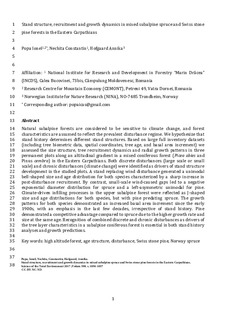Stand structure, recruitment and growth dynamics in mixed subalpine spruce and Swiss stone pine forests in the Eastern Carpathians
Journal article, Peer reviewed
Accepted version

Åpne
Permanent lenke
http://hdl.handle.net/11250/2489483Utgivelsesdato
2017Metadata
Vis full innførselSamlinger
- Publikasjoner fra CRIStin - NINA [2364]
- Scientific publications [1392]
Originalversjon
Science of the Total Environment. 2017, 598 1050-1057. 10.1016/j.scitotenv.2017.04.169Sammendrag
Natural subalpine forests are considered to be sensitive to climate change, and forest characteristics are assumed to reflect the prevalent disturbance regime. We hypothesize that stand history determines different stand structures. Based on large full inventory datasets (including tree biometric data, spatial coordinates, tree age, and basal area increment) we assessed the size structure, tree recruitment dynamics and radial growth patterns in three permanent plots along an altitudinal gradient in a mixed coniferous forest (Picea abies and Pinus cembra) in the Eastern Carpathians. Both discrete disturbances (large scale or small scale) and chronic disturbances (climate change) were identified as drivers of stand structure development in the studied plots. A stand replacing wind disturbance generated a unimodal bell-shaped size and age distribution for both species characterized by a sharp increase in post-disturbance recruitment. By contrast, small-scale wind-caused gaps led to a negative exponential diameter distribution for spruce and a left-asymmetric unimodal for pine. Climate-driven infilling processes in the upper subalpine forest were reflected as J-shaped size and age distributions for both species, but with pine predating spruce. The growth patterns for both species demonstrated an increased basal area increment since the early 1900s, with an emphasis in the last few decades, irrespective of stand history. Pine demonstrated a competitive advantage compared to spruce due to the higher growth rate and size at the same age. Recognition of combined discrete and chronic disturbances as drivers of the tree layer characteristics in a subalpine coniferous forest is essential in both stand history analyses and growth predictions. © 2017 Elsevier B.V. All rights reserved. High altitude forest Age structure Disturbance Swiss stone pine Norway spruce
